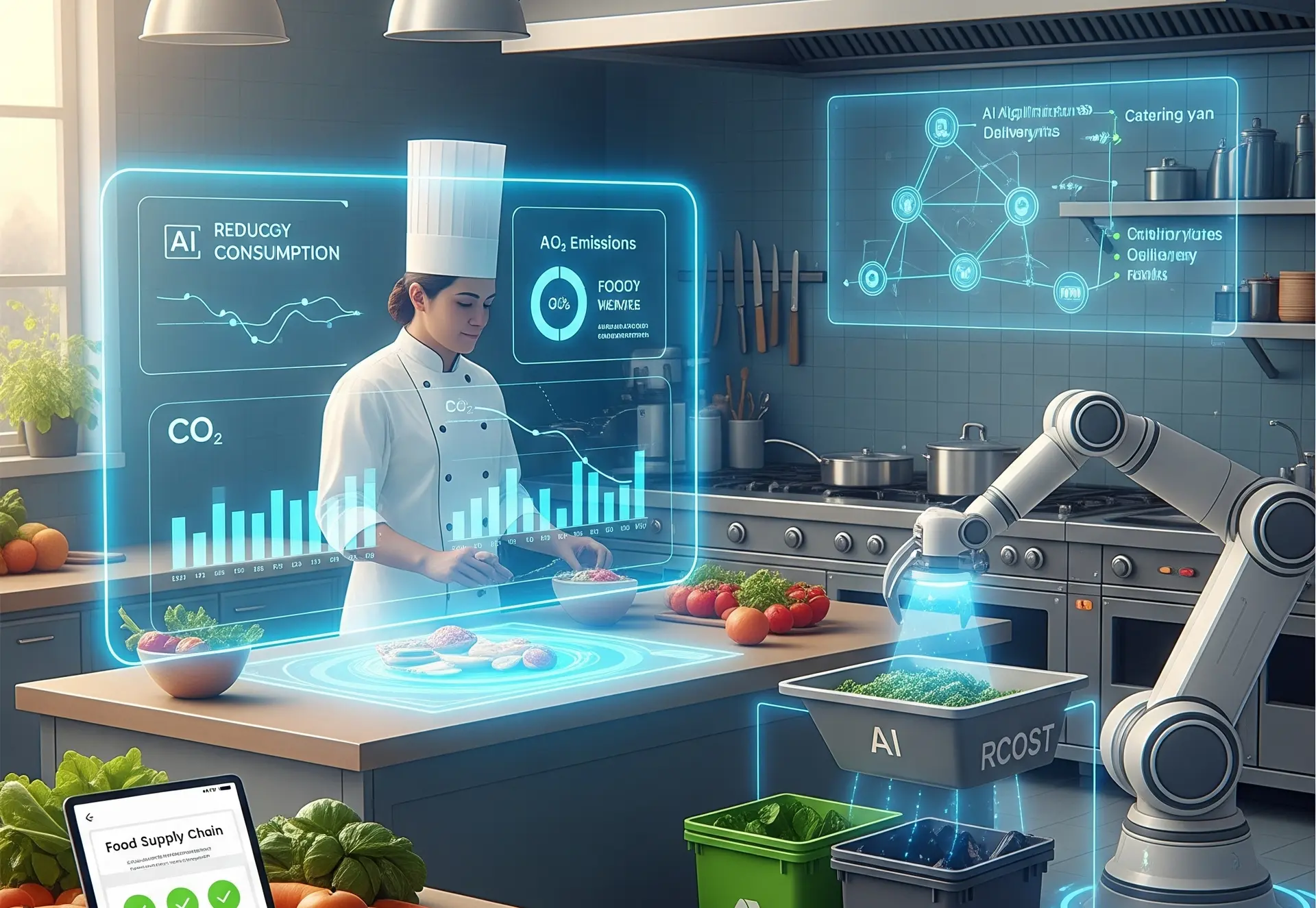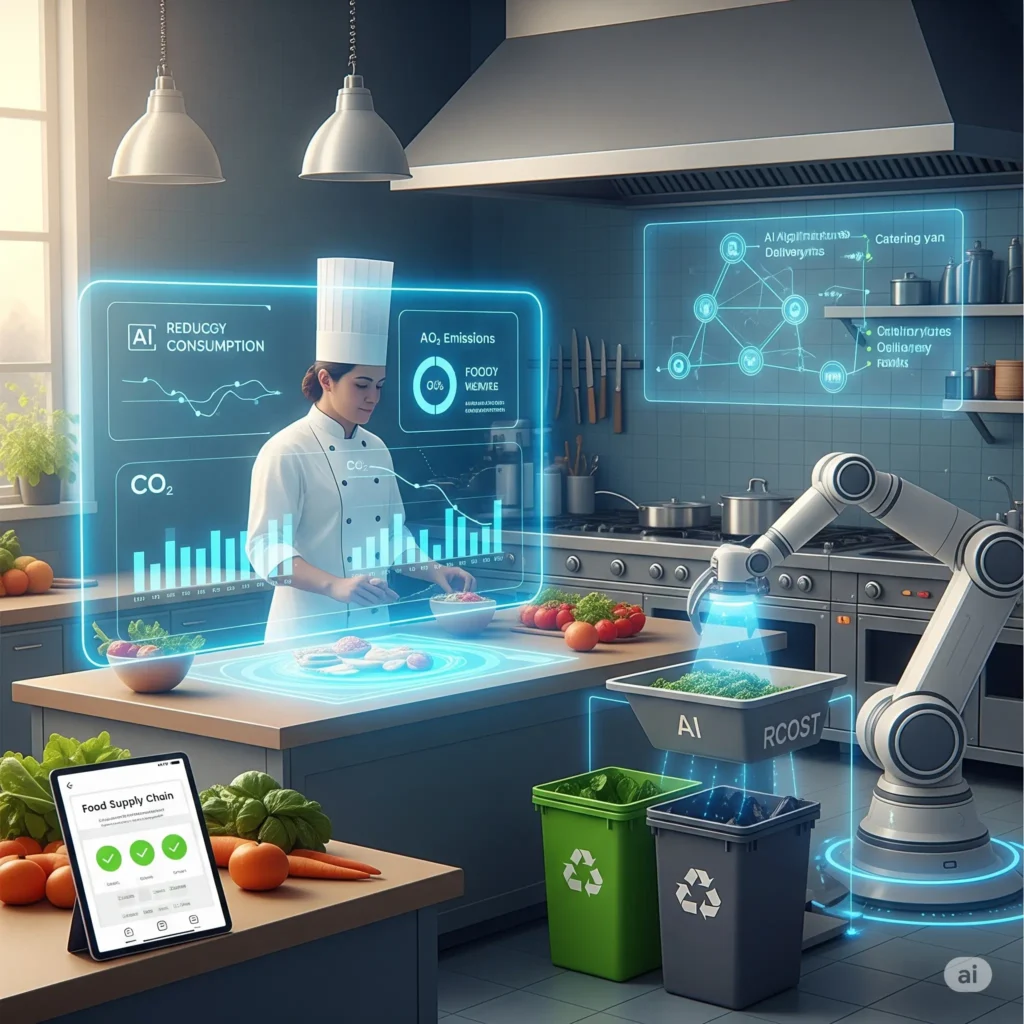
Sustainable Foodservice
3 Ways AI Is Helping Restaurants Cut Carbon Emissions
As sustainability becomes a top priority across industries, ESG (Environmental, Social, and Governance) considerations are now front and center—even in the food and beverage sector. For restaurant operators, the challenge is clear: how to maintain profitability and operational efficiency while taking meaningful action on carbon reduction and long-term environmental impact.
It’s worth noting that while AI (Artificial Intelligence) has been largely adopted to drive automation and boost efficiency, its role in sustainability is becoming increasingly evident. As more food businesses implement AI technologies, they’re discovering unexpected benefits—particularly in reducing waste, cutting emissions, and optimizing resource use.
In this article, we explore three real-world applications where AI is helping food businesses take meaningful steps toward a low-carbon future for the foodservice industry.
Reducing Delivery Errors with AI Vision Technology
With food delivery becoming a core part of restaurant operations, order errors have become a costly and environmentally damaging issue. Mistakes during meal prep—like incorrect portions, missing ingredients, or wrong items—often result in remakes and redeliveries. This not only wastes staff time and packaging materials but also increases fuel consumption and carbon emissions.
By installing a camera at the final check-out station, AI-powered image recognition systems can instantly verify that each order matches the ticket—right down to portions and special requests. If a mismatch is detected, staff are alerted immediately for correction.
This adds a second layer of quality control on top of human checks, significantly reducing order errors and unnecessary trips. The result? Less packaging waste, lower fuel usage, and a better customer experience. It also shortens the learning curve for new hires, helping ensure consistent food quality from day one.
The larger the volume of delivery orders, the greater the impact—both in operational savings and emissions reduction.
What makes this technology especially attractive is how easy it is to implement. Take Viscovery’s AI-powered image recognition system, for example: it only requires a single camera installed at the final order check station, paired with a trained AI model, to create a fast and reliable double-check process. The system has already been adopted by several restaurant brands in Japan.
For these businesses, it’s a low-cost, high-impact solution that not only enhances customer satisfaction and builds brand trust, but also serves as a practical entry point for embracing ESG practices. In many ways, it marks the first meaningful step toward AI-powered, low-carbon operations.
Related Article: Real-World Challenges in AI Food Recognition (Part 1)
Related Article: Real-World Challenges in AI Food Recognition (Part 2)
Smarter Forecasting to Minimize Food Waste
One of the biggest contributors to carbon emissions in the foodservice industry is over-prepping ingredients—and the energy required to refrigerate them. In an effort to avoid stockouts and missed sales, many restaurants overstock, only to end up discarding unsold food. The result? A double hit: financial losses and environmental damage.
According to ReFED, a U.S. nonprofit dedicated to reducing wasted food, the issue cost the U.S. economy an estimated $338 billion in 2023, with $107 billion coming from the food and restaurant sectors alone1. As OzHarvest, an Australian food rescue organization, put it bluntly: “If food waste were a country, it would be the third-largest emitter of greenhouse gases in the world2.”
Food typically makes up 30% to 50% of a restaurant’s total operating costs2. That’s why accurately forecasting demand is more than a smart business move—it’s a major step toward sustainability. Today, more restaurants are turning to AI to predict daily ingredient needs based on historical sales, weather patterns, holidays, and promotions. The payoff? Less over-ordering, less energy use, and less waste.
Platforms like ClearCOGS help restaurants optimize prep and purchasing by analyzing sales history and recipe data, improving efficiency across the board3. Another startup, Restoke.ai, uses AI to streamline and automate inventory and cost control—saving clients an average of $8,000 per week, largely through reduced food waste4.
ReFED also notes that modern AI tools can synthesize data from inventory systems, point-of-sale platforms, and even waste bins to generate actionable insights. These insights empower businesses to make smarter, data-driven decisions that directly reduce their carbon footprint5.
Because food waste isn’t just about what ends up in the trash—it represents a long chain of wasted resources, from production and packaging to cold-chain logistics and final disposal. By stopping that waste before it starts, AI is emerging as a powerful ally in the fight against climate impact in foodservice.
Optimizing Cold Chain and Delivery Logistics
For large restaurant chains, central kitchens, and cold-storage suppliers, emissions are closely tied to how efficiently they manage fuel use and energy consumption. Perishables like seafood, produce, and pharmaceuticals require precise temperature control—making them early adopters of advanced logistics technology.
Now, AI is raising the bar even higher.
By analyzing real-time data such as traffic patterns, delivery routes, vehicle loads, and weather forecasts, AI can optimize routing, dispatching, and scheduling in ways that minimize both fuel usage and delays. When integrated with cold-chain operations, AI systems can optimize onboard refrigeration to maintain food freshness while reducing emissions.
The results speak for themselves: some retailers have already cut fleet fuel consumption by 18% and reduced delivery times by 12% through AI-driven logistics6.
As Ron Leibman, chair of the Transportation, Logistics & Supply Chain group at McCarter & English, puts it:
“The methods for optimizing delivery routes have always existed—but AI makes it faster, smarter, and significantly more impactful7.”
AI as a Catalyst for Green Dining
From global supply chains to corner cafés, low-carbon operations are fast becoming standard practice. Sustainability is no longer optional—it’s essential for food and beverage brands of every size.
With ESG at the forefront of business strategy, restaurants are turning to AI to drive both efficiency and sustainability—from smarter kitchens to greener logistics and better energy use—all while delighting guests.
The journey can start with identifying top ESG priorities and setting measurable KPIs—such as monthly food waste rates or the frequency of delivery corrections. From there, AI tools can continuously monitor, analyze, and optimize daily operations to drive real, data-backed progress.
AI isn’t just a trend—it’s a practical engine for turning sustainability goals into real-world results. By leveraging AI, foodservice providers can reduce their environmental impact, strengthen operational resilience, and build a greener future for the industry.

[Explore More]
👉 2025 Foodservice Industry Trends: Key Insights for Staying Competitive
👉 5 Innovative Image Recognition Applications in Food Service
👉 How is AI Used in the Bento Industry: Enhancing Operations from Checkout to Quality Control
[References]
1 “Food Waste Data—Causes & Impacts.” ReFED, https://refed.org/food-waste/the-problem. Accessed 4 Aug. 2025.
2 Lynch, Jared. “Melbourne Start-Up Fresho Aims to Tackle $940bn Food Waste Crisis.” Fresho, 3 Dec. 2024, https://www.fresho.com/resources/company-news/melbourne-start-up-fresho-aims-to-tackle-940bn-food-waste-crisis. Accessed 4 Aug. 2025.
3 Joseph, Danielle. “How AI Can Reduce Food Waste at Restaurants.” Closed Loop Partners, 11 April 2025, https://www.closedlooppartners.com/how-ai-can-reduce-food-waste-at-restaurants/. Accessed 4 Aug. 2025.
4 Santoreneos, Anastasia. “Hospo-Tech Raises $5.1 Million to Save Restaurants amid Flailing Industry.” Forbes Australia, 24 Sep. 2024, https://www.forbes.com.au/news/innovation/hospo-tech-raises-5-1-million-to-save-restaurants-amid-flailing-industry/. Accessed 4 Aug. 2025.
5 “Three Ways AI Is Driving Reductions in Food Loss and Waste.” ReFED, 22 Oct. 2024, https://refed.org/articles/three-ways-ai-is-driving-reductions-in-food-loss-and-waste/. Accessed 4 Aug. 2025.
6 Sapra, Yatin. “AI in Food Industry: Reducing Waste and Improving Sustainability.” HashStudioz Technologies, 10 April 2025, https://www.hashstudioz.com/blog/ai-in-food-industry-reducing-waste-and-improving-sustainability/#Optimizing_Logistics_for_Reduced_Carbon_Footprint. Accessed 4 Aug, 2025.
7 Kapadia, Shefali. “AI is Slowly Transforming the Cold Chain, the Supply Chain That Handles Your Ice Cream and Deli Meat.” Business Insider, 22 July 2025, https://www.businessinsider.com/ai-for-cold-chain-operations-safety-algorithms-agents-digital-twins-2025-7. Accessed 4 Aug. 2025.

